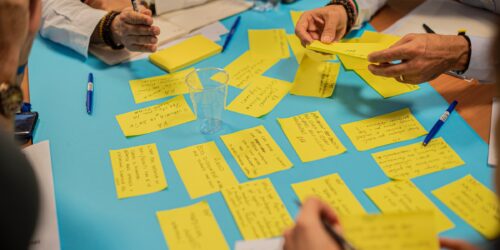Reach Them All with Universal Design for Learning
Universal Design for Learning (UDL) is about making course instruction, materials, and content accessible to everyone right from the start. By doing this you will reduce the need for later adjustments or special accommodations which can be time consuming. By using the ideas and tools from UDL to build flexibility and options into your courses, UDL ensures that everyone can engage with your course material without barriers.
Before reading further, watch and listen to your colleagues talk about UDL in higher education.
UDL Principles
There are three guidelines associated with UDL that support a UDL learning environment: multiple means of engagement, representation and action & expression. You are encouraged to review the details of those guidelines along with the checkpoints that act as suggestions for implementation. Figure 1 shows the big ideas surrounding those guidelines that we will refer to within this post.

Figure 1. The three big ideas for promoting Universal Design for Learning
Multiple Means of Engagement
UDL invites teachers to start with the with the ‘why’ of learning. This is where you provide the motivation about why your students expected to be interested in your course, beyond just receiving a grade.
You want your students to want to learn during your classes. It is here you provide the relevance and value of the learning they are required to do. For example, you can generate initial interest by demonstrating the relevance and value of your course by providing a ‘bridge’ for each of your lessons. This could be an employment scenario from your experiences, a personal story, a current event, or a short student-centred activity.
Providing opportunities for students to receive feedback about their learning can also promote ongoing engagement in your course. For example, feedback technology tools such as Mentimeter can deliver questions to students that provide feedback on their learning while Padlet can provide opportunities for students to share thoughts and ideas within a public, online space. And if you teach online, take advantage of the annotate tools or polling features you can find within the online platforms such as Zoom or Teams. In this way, you can ask questions and receive feedback that engage students with your online content.
Engage further by creating a sense of community and collaboration with your students and with each other. You can start this by simply getting to know student names and having short one-on-one conversations with students about their progress and their challenges. If you teach in-person, use the think-pair-share model of engagement during your teaching to build community and collaboration. If you teach online, use think-pair-share but within breakout rooms.
Multiple Means of Representation
Now that you have established the motivation or ‘why’ of learning, now look to the ‘what’ you are going to teach.
As you teach your content, think about how that material is being received by your students. Quite often, we present class material using PowerPoint as a delivery method. In addition to the text on your slides, you might support that text using multiple media such as images, video, graphs, concept maps, flow charts or live demonstrations. In this way, you provide options for both visual display and auditory processing that some students may require – and that most others would appreciate. Finally, consider displaying your voice in a text ribbon across the bottom of your PowerPoint slides as you talk. To do this, use the search bar in PowerPoint and search for ‘accessibility’. Then click on ‘Always use subtitles’. In this way, you help students who may have auditory processing difficulties.
Multiple Means of Action & Expression
This is the ‘how’ of learning, meaning how we might provide choices for students to express their learning so that your course outcomes are realized.
At some point, you will want your students to express what they have learned. Consider going beyond the common ‘paper and pencil’ style of assessment. Instead, give students multiple means and tools for expressing their understanding so that all students can play to their strengths as learners. For example, give students choice in submitting assignments that might go beyond text-based submissions such as verbally articulating their understanding, allowing video-based submissions, or having them create a PowerPoint presentation and provide a recording of their voice explaining their work. In doing so, you give options for expressing their understanding using oral traditions where students may excel, particularly if they have difficulties with language and writing. You could also have students represent their work using graphical approaches such as concept maps, mind maps, or infographics. In summary, give students options to re-package knowledge and understanding in ways that play to the students’ strengths as learners.
Finally, help students during action and expression by providing appropriate short-term and long-term goals for assessment completion. This can be done effectively by providing checklists or provide short feedback as they complete their assessments. Feedback has been found to be a very powerful action to improve student learning and evaluation (Hattie, 2008). Much like how you received feedback from your driving instructor prior to a driving test, students too should have had opportunities receive feedback prior to the final evaluation in your course. It is a fair and kind thing to do.
Watch the following short video has he describes how the three guidelines interconnect to produce accessible learning for all students.
Get Started Using the Plus-One Approach
To get started with UDL in your practice, pick one idea to implement and practice. For example, check your slide deck and ensure that you have visual information that accompanies your text (multiple means of representation). Then when you are comfortable, add in a second idea, perhaps trying a think-pair-share (multiple means of engagement). This plus-one approach will prevent you from being overwhelmed with the all the checkpoints that make up the UDL guidelines.
Remember, that implementing UDL is not an event, it is a process. So, take the time you need to implement UDL successfully so that it becomes a consistent part of your teacher toolbox.
References
BOPPPS Lesson Planning Poster: https://tlconestoga.ca/downloads/
Universal Design for Learning UDL: The UDL Guidelines (cast.org)
Hattie, J. (2008). Visible learning. Routledge.



